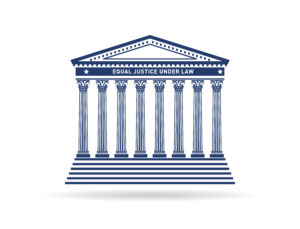
The Supreme Court is known as the “Highest Court in the Land,” but even this highest court needs to justify its choices. Scholar Martin Shapiro referred to this universal judicial norm as part of the logic of the triad. Under this logic, judges maintain a system of trust with the public by providing seemingly neutral support for their decisions. This is why disseminating opinions to the people is of utmost importance. In giving reasons for their decisions, Supreme Court Justices often call upon legal scholarship to buttress their points. That is where citations to law journals come into play.
The Supreme Court’s decision last term in New York State Rifle & Pistol Assn., Inc. v. Bruen is instructive on this relationship. Justice Thomas’ majority opinion in Bruen looked at the historical context of the Second Amendment to support his decision regarding the (un)constitutionality of New York’s proper-cause requirement for obtaining an unrestricted license to carry a concealed firearm.

The Law Firm’s Guide To Trust Accounting And Three-Way Reconciliation
Proper trust accounting and three-way reconciliation are essential for protecting client funds and avoiding serious compliance risks. In this guide, we break down these critical processes and show how legal-specific software can help your firm stay accurate, efficient, and audit-ready.
Thomas wrote on pp. 19 and 20,
“When confronting such present-day firearm regulations, this historical inquiry that courts must conduct will often involve reasoning by analogy—a commonplace task for any lawyer or judge. Like all analogical reasoning, determining whether a historical regulation is a proper analogue for a distinctly modern firearm regulation requires a determination of whether the two regulations are ‘relevantly similar.’ C. Sunstein, On Analogical Reasoning, 106 Harv. L. Rev. 741, 773 (1993). And because ‘[e]verything is similar in infinite ways to everything else,’ id., at 774, one needs ‘some metric enabling the analogizer to assess which similarities are important and which are not,’ F. Schauer & B. Spellman, Analogy, Expertise, and Experience, 84 U. Chi. L. Rev. 249, 254 (2017).”
The two law review articles Thomas cited in this passage clarify the importance of historical examples in legal reasoning surrounding modern law. The purpose these citations serve is to bifurcate Thomas’ position with support from outside of case law for making a logical connection between two scenarios separated by a long stretch of time. Citations to law journal articles often play this role of supporting positions where case law alone does not provide the foundation the justice seeks. These citations also create a feedback loop where law professors (generally) see the importance of their work and attempt to provide more clarification for the justices who then cite these articles in more opinions.
I looked at this topic several years ago and highlighted the importance of the academic scholarship in the justices’ decisions during the 2016 and 2017 terms. This post covers citations to law journals for the 2021 Term and 2022 Term through the decisions released on June 8th 2023. It does not cover books the justices cited. There were 200 citations in all and these broke down into 60 articles cited in majority opinions and 140 articles cited in dissents and concurrences. I counted citations based on each article cited in an opinion, so if an article was cited in multiple opinions in the same case, it would be counted multiple times, but if an article was cited multiple times within the same opinion, it would only be counted once.

Skills That Set Firms Apart
Legal expertise alone isn’t enough. Today’s most successful firms invest in developing the skills that drive collaboration, leadership, and business growth. Our on-demand, customizable training modules deliver practical, high-impact learning for attorneys and staff—when and where they need it.
A few interesting points to note at the outset. First, the justices’ own articles were cited three times in this set of opinions. Justice Gorsuch cited Justice Barrett’s Boston University Law Review article “Substantive Canons and Faithful Agency” in his opinion in West Virginia v. EPA. Justice Kavanaugh cited his own articles twice. The first time was in Wooden v. United States when he cited his Harvard Law Review article titled “Fixing Statutory Interpretation.” The second was in Ramirez v. Collier when he cited his Notre Dame Law Review article “Two Challenges for the Judge as Umpire: Statutory Ambiguity and Constitutional Exceptions.”
Next, Professor Michael McConnell led the way in articles cited with eight citations across different opinions during this period. There was also an error in Justice Thomas’ citation of Engdahl’s Duke Law Journal article in his recent opinion in the Talevski case incorrectly referring to Duke Law Review instead of Duke Law Journal. We’ll see if the justice cleans this up.

Lastly, and from an empirical perspective is it notable that several articles cited were from empirical law journals – the Journal of Legal Analysis and the Journal of Empirical Legal Studies – and another article, Howell and Lewis’ “Agencies by Presidential Design,” was cited from the political science journal the Journal of Politics.
Now for the citation data and analysis. The two justices that cited the most law journal articles were the same ones who cited the most in my previous post on this topic – Justices Thomas and Justice Gorsuch. While Justice Thomas cited many more than Justice Gorsuch previously, they cited an equal amount this time around.

The 60 citations apiece far outpaced any of the other justices during this period. Justice Gorsuch cited more articles than Justice Thomas in majority opinions. Justice Alito had the next most total cites with 18. Justice Jackson who began her work on the Court this term had the lowest count with two, and if we add those to her predecessor, Justice Breyer’s count from last term, the total is still only 13.
Next when we look at the cases where at least two articles were cited we see some surprises.

The most articles cited in a case was 26 in U.S. v. Vaello Madero, a case where the Court decided that the Constitution does not require Congress to extend Supplemental Security Income benefits to residents of Puerto Rico. This case outpaced the three cases where one might have surmised we would see the greatest number of articles in Bruen, Dobbs, or West Virginia v. EPA. The most cites in a decision so far this term was 11 in Sacket v. EPA followed by 10 in the Talevski case.
The justices pick the articles they cite from a bevy of journals that all generally accept articles on similar topics. There is a (not surprising) correlation with more citations going to articles in higher ranked journals, but the ordering of these journals is interesting as are the journals which were cited more frequently than would be assumed based on a journal’s ranking alone.

Yale’s Law Journal was cited more frequently than journals from any other school at 28 times. After Yale and Harvard, several other highly ranked schools’ journals were cited most frequently including Columbia, Virginia, and Stanford. Some potential surprises given journals’ rankings alone were Cardozo in the 12th spot and Santa Clara in the 14th position. Schools with fewer than two articles cited were not included in this chart.
Finally, certain justices had a propensity for citing articles from certain schools’ journals. The following chart looks at justices that cited multiple articles from the same schools’ journals.

The leading relationships were between Justice Thomas and Yale Law Journal with 12 cites and Justice Gorsuch and Harvard’s law journals with 11. Justice Gorsuch’s high cite counts to Michigan and Notre Dame’s law reviews were also notable.
What does all of this tell us? It highlights the importance of this feedback loop where law professors write articles that create support for the justices’ positions in their decisions, and the justices’ citations help generate more interest driving such scholarship. The importance of school and journal ranking is important to this measure as more articles are generally cited from higher ranked schools and journals. What this doesn’t tell us though is whether justices assign quality to articles based on the journal ranking or if scholars who are superior in the justices’ eyes tend to work at higher ranked institutions. These correlations help us make predictions about whose articles may be cited in the future although they are not outcome determinative as we see articles from certain schools clearly cited at a higher rate than would be expected from school and journal ranks alone. It will be interesting to know what these schools and professors are doing differently to surpass the assumption for how frequently we would expect their articles to be cited. We can save that though for another day.
Adam Feldman runs the litigation consulting company Optimized Legal Solutions LLC. For more information write Adam at [email protected]. Find him on Twitter: @AdamSFeldman.